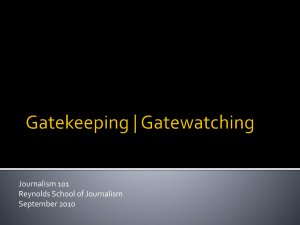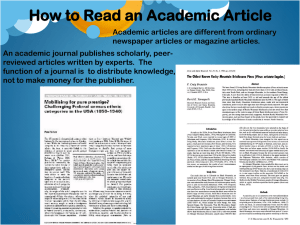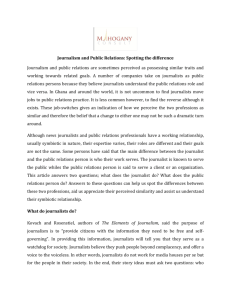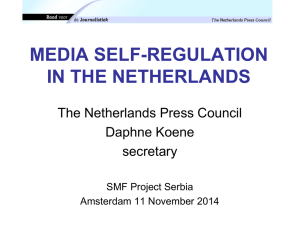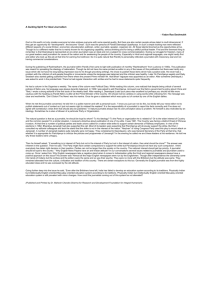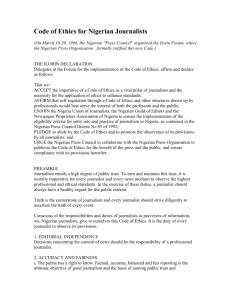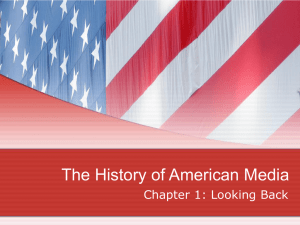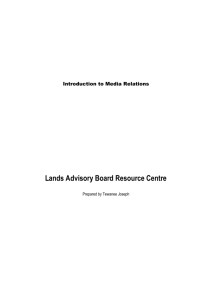Media engagement
advertisement
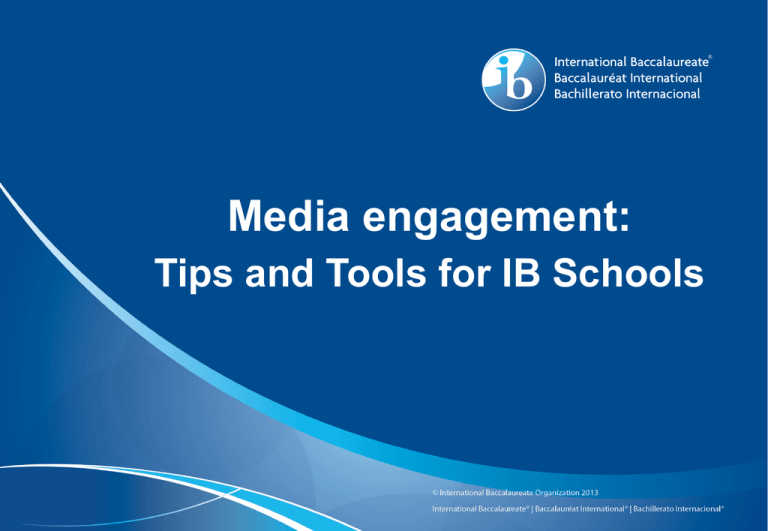
Media engagement: Tips and Tools for IB Schools Reasons for engaging with the media - I • It can help to raise your school’s profile in a cost effective way • Understanding the media and how it can be used to your advantage gets your story into new channels that it might not appear in as part of existing marketing activities • Your stakeholders consume media in one way or another, meaning that they will hear your story and be influenced, ideally in a positive way • Positive comments from the media make powerful endorsements that can be used in your marketing materials • Establishing long-term relationships with journalists makes it easier to secure coverage Page 1 Reasons for engaging with the media - II • As an IB school you have a unique story to tell, setting you apart from other schools in your area • Unlike many other schools, yours is part of a wider IB family • The more schools there are telling the IB story, the greater the awareness of the programme and its benefits • This is supported by on-going media engagement from the IB at a global and regional level • Using media tactically/creatively to disseminate positive messaging can influence parents, which can in turn increase take up of IB programmes • The IB has developed a set of global messages which makes engaging with the media easier Page 2 Whom you are trying to reach Parents Governors/ School Board Employers Students Media Local community Teachers Government and local government/ School Districts Universities/ Colleges Page 3 Who can talk about your school and the IB Testimonials and first person narrative can strengthen any story. There are often three different types of people that you can work with to convey the messages that you want to communicate: 1) Spokespeople – people that directly represent your school, deliver services and who are best positioned to talk about the issues you want to discuss 2) Ambassadors – people who are engaged with your school, know what you offer and who are able to talk about the services you offer, from a user’s perspective 3) Third parties – those who are aware of your school and who understand the benefits of the services you offer ALUMNI PARENTS HEAD TEACHERS STUDENTS TEACHERS IBO GOVERNORS /SCHOOL BOARDS ASSOCIATIONS UNIVERSITIES & COLLEGES COMMUNITY PARTNERS LOCAL GOVERNMENT REPRESENTATIVES EMPLOYERS THIRD PARTIES Page 4 PR opportunities: planned or reactive • News stories • Comment • • • • • Results and university acceptances New programme introduced New IB research Events and community projects Success story (e.g. “Student raises $5,000 for local charity”) School open days • Responding to relevant issues: government announcements, reports, joining in with conversations on Twitter & other social media channels Op-ed piece Interview Letter to editors • • • • Possible feature ideas to consider • • • • • • • • • • Day in the life of an IB student/teacher/school Media visit to school Profile of school leavers and alumni International projects Creativity and the arts in the IB performances/art shows Local employer partnerships Enterprise schemes The IB and employability The IB and language – international connections IB students engaging in community projects Page 5 Inside a journalist’s world - Overview • • • • • • • • • A journalist writes around 5 or 6 different stories a day Also contributes to blogs, social media feeds and can also be doing some freelance work Faces multiple deadlines so there’s no ‘good’ time of day to get in contact, but there times when they are less under pressure – generally mid morning and late afternoon can be better Has many contacts to speak to each day Often away from their desk for interviews and meetings Doesn’t necessarily write the headline for the story The decision on the story’s angle and size is the editor’s Knowledge of education news and issues varies widely between journalists Is one part of a larger editorial team putting together ‘your story’ Page 6 Inside a journalist’s world – Maximise the chances of getting coverage I • Keep it brief and focused • Get straight to the story - Include what, why, when, how, who? • Don’t be afraid to pick up the phone – emails don’t always get read or answered • Be clear about what you are offering a journalist • Use third party endorsements to strengthen your story • Offer case studies of people or projects to bring the story to life • Have high resolution photographs and stock footage available for local media • Video content also helps as newspapers have a high demand for online video • Have background information ready to send over on request Page 7 Inside a journalist’s world – Maximise the chances of getting coverage II • • • • • • • • • Understand the best times of day to get in touch Know whom to contact Don’t ramble Avoid using jargon or being overly technical Try not to let it come across as a sales pitch Don’t just make it up – you’ll need to include references Avoid contacting journalists excessively Don’t recycle old data or stories Don’t necessarily expect immediate success, you need to spend time investing in building • Relationships with journalists Page 8 Contacting a journalist Press release • Ensure that the headline is concise • Include all the facts upfront – don’t bury the story • Include relevant quotes • Include further details that aren’t central to the story in ‘Notes to editors’ • Keep it to a maximum of two sides Email • Keep it short and begin with 2/3 bullet points summarising the story • Ensure that it’s personalised • Don’t send attachments unless requested • Include a low resolution image in the body, if central to the story Phone call • Before launching into your pitch, check with the journalist that it’s a good time for them • Tell your story in one sentence and then elaborate with 15 second nuggets • Capitalise on a ‘no’ by finding out what their interests are • Keep voicemail messages short and follow up with an email Twitter Events Meetings • Don’t ask journalists for anything • If they ask for help and you can be of assistance, help them out • Share and comment on their content • Learn about them and briefly demonstrate your knowledge when you make contact • Keep your stories at the front of mind and be ready to briefly discuss them if appropriate • Give your details and suggest meeting up at a later date to discuss how you can work with them in the future • Follow up with an email a few days later • Ensure that your spokespeople are well briefed beforehand • Invite the journalist to the school for a meeting but if they can’t travel that far, offer to meet near their office • Follow up with information after the meeting Page 9 Interviews – the ten rules If you don‘t want to answer, say so You only have control over what you say, not what the journalist says 3. Always Write down what you want to say before the interview 4. Identify three key messages, and keep returning to them 5. Make sure you believe in what you say 6. Make sure you understand the question 100% before answering 7. Use your expertise and superior knowledge to your advantage 8. You shouldn’t assume that all interviews are hostile 9. Remember that journalists are human beings 10. Make sure you’ve researched what the journalist has written before 1. 2. Page 10 Interviews – dealing with tricky questions a) If the reporter loses focus, or goes off on an unimportant tangent b) If controversial, uncomfortable or unflattering topics are raised • • • • • • • • Keep three key messages front of mind Don’t act as if the question hasn’t been asked Stop when you have answered the question If you really need time to think, ask the reporter to repeat the question Challenge an assumption if you disagree with it Never repeat negative assumptions Don’t comment on something you don’t know about End every answer with a key message Page 11 Interviews – follow the ABC technique • Acknowledge the question or a fragment from within the question: • That is an interesting point • I am glad you asked about x • You have got to the essence of the issue in touching on x • Bridge by continuing with a brief transition: • Actually • I would characterise that differently • What I can tell you is this • Communicate your key point and message: • Look, the key point is… • I think you really must understand that.. • The key point in this area is… Page 12 Social media - I • • Support your news story by populating your own online channels. As well as sharing information publicly, it also allows you to communicate news to internal and external stakeholders (e.g. students, educators, parents). Some relevant channels are: • Twitter feed • Facebook page • LinkedIn page • YouTube channel • Newsletters • Information about press contacts clearly visible on your website • Blogs • Remember that social media is about listening and engaging, not broadcasting Page 13 Social media - II • Use social media to develop relationships with media as well, as other relevant organisations that are interested in the issues you are discussing • Comment on online stories and blog posts • Share content • Join online networks and make sure your content is valuable • Encourage your ambassadors to talk about your school and the IB both online and offline and where relevant, give them resources to help them best manage their own “brands” • Have a basic social media policy in place to ensure that individuals representing the school (e.g. educators) aren’t communicating information that strongly conflicts with what you’re saying Page 14 Some considerations • When talking about the IB and its programmes, in any form, consider the following: • Can your communications be supported by your and the IB’s messaging? • Are you using the most up-to-date information? • Have you referred to www.ibo.org for the latest facts and figures? • Can you support your communications with additional information, such as logos and/or images, to make the story more interesting? • Are the logos you are using for the IB the most up to date versions? (see IB website) • If you have any questions, please contact your regional coordinator, who will be happy to help: Asia-Pacific Sebastien Barnard sebastien.barnard@ibo.or g The Americas Robin Khan robin.khan@ibo.org Europe, Middle East, Africa Robert Cummings Robert.cummings@ibo.org Global ‘Corporate’ Communications Janneke Versteeg janneke.versteeg@ibo.org Page 15

